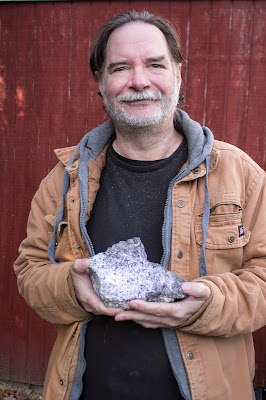In the image
above, the specimen he holds is ore quality black chromite coated with violet colored chromian clinochlore (aka kammererite, rhodochrome, penninite) and white talc. He collected it at Bare Hills in Baltimore County. Until he uncovered this and other similar specimens, such material had not been collected in the area for nearly a century. The find is one of Maryland's most significant in the past 50 years.
Field collecting in Maryland has become immensely challenging. Localities that once yielded specimens have given way to sprawl. Strictly enforced laws prohibit collecting in state parks and national parks. Other sites are on private property that effectively forbid trespassing. Most of the few quarries that formerly allowed once a year visits from properly insured mineral societies now proclaim that liability issues prevent them from doing so.
How is it that Stuart is able to devote a major portion of his time to successfully collecting mineral specimens in and near his home state? He focuses much of his approach on rediscovering long forgotten localities, many of them no longer believed to exist.
Plenty has been published during the past two centuries regarding Maryland localities that at different periods were known to have yielded a variety of mineral species. Over time, most of these localities have been built over or otherwise become inaccessible or forgotten. Most of what was written about them appeared in a variety of publications that became obscure, some nearly impossible to obtain, until several years ago. Finally, the Internet came to the rescue.
Minerals of Maryland by Charles Ostrander and Walter Price was one such publication that in its day, many considered a "Bible" for such information. It named and briedly described by county most of Maryland's known localities and listed all the mineral species reported from each one. The Natural History Society of Maryland, which published it in 1940, made Minerals of Maryland available on line just three years ago.
Nearly as recently, Maryland Geological Survey similarly brought on line more extensive and specific information about the localities noted in Minerals of Maryland and added additional ones. Some of the varied publications provide maps that make finding these localities easier.
Lidar data in LAS files, especially when accessed with Arc Gis, has provided collectors with an additional tool for seeking out localities. The technology provides collectors with a description of the earth contours throughout the vicinities where the localities---if any traces of them still exist--- appear on the maps.
Such wonderful tools will only prove helpful to collectors with the knowledge to identify specific species as well as how to search for any that remain. Such knowledge combined with Stuart's extensive collecting experience and the time he has available to collect give him his edge. It helps that he earns a substantial portion of his livelihood as a mineral dealer.
In past posts, Mineral Bliss has feautred several finds Stuart has brought to light. They are as follows:
The Carroll Mine in Carroll County, Maryland
New Finds: Falls Road Corridor Near Baltimore City Line
The Garnets of Stony Run in Baltimore City
Stuart very likely has had more experience collecting at the Mineral Hill Mine in Carroll County than anyone else alive today. One of his proudest finds from the immediate vicinity of this iron and later copper mining operation dating from the 17th Century is pictured at left. The specimen bears silvery carrollite-siegenite with golden chalcopyrite in magnetite. The carrollite-siegenite portion measures to nearly an inch, which is considerably larger than the vast majority of the eponymous Carroll County carrollite examples curently known to exist. Stuart's most spectacular find in our opinion was the deposit of ore quality chromite with chromian clinochlore from Bare Hills in Baltimore County that he holds in our title picture.








